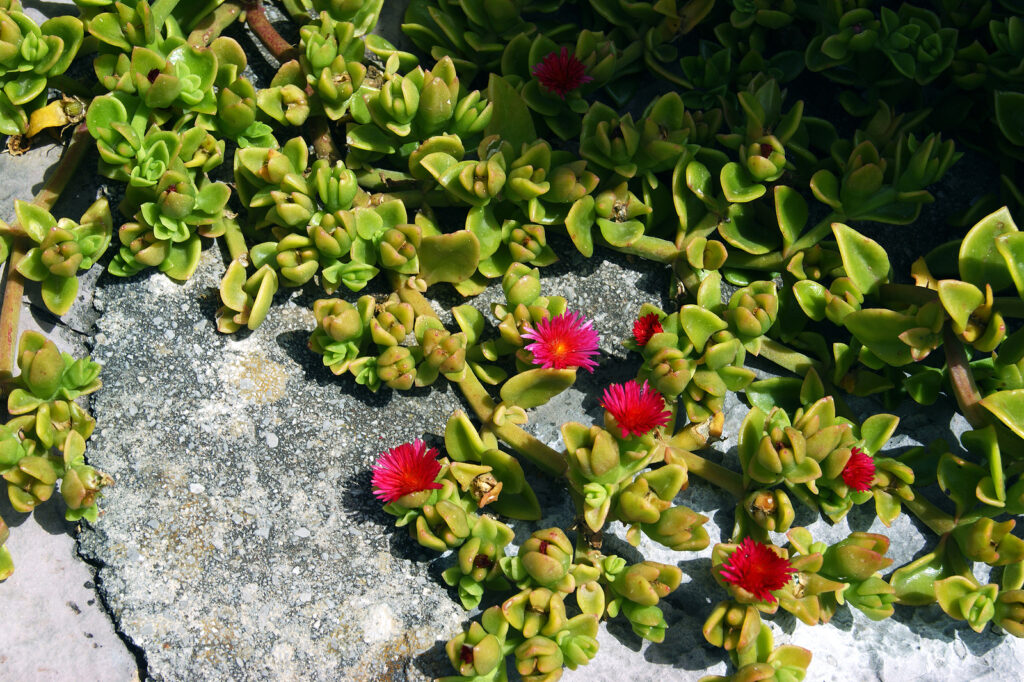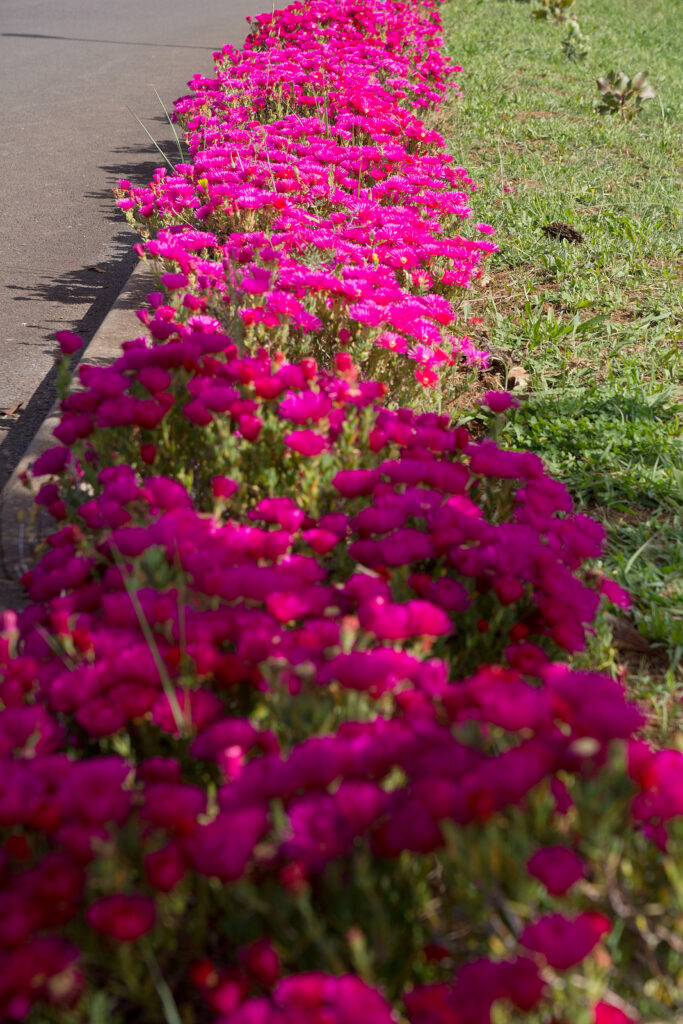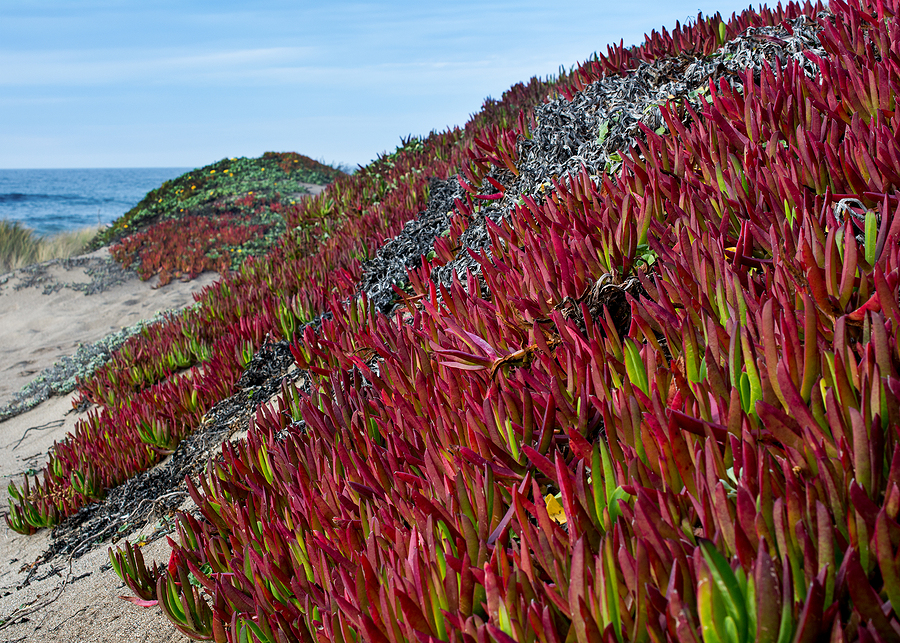Ice plant is the name given to several colorful low-growing plants often used as groundcovers—especially in mild winter regions, but also grown as houseplants in cold winter regions. These perennial plants are grown as summer-flowering annuals for window boxes and hanging baskets as well.
Ice plants are commonly succulent perennials, subshrubs, or annuals. Almost all have daisy-like flowers although none are members of the daisy or Asteraceae family. Ice plants have petals surrounding a darker eye—each bloom is actually a single flower. True daisies bear heads that consist of many individual flowers.
Almost all ice plants are evergreen or semi-evergreen and mat-forming.
Nearly all ice plants once belonged to the genus Mesembryanthemum, however, taxonomists in recent years have reclassified them into smaller groups.
All ice plants need full sun. They all will grow in poor, sandy to average soil, but they do demand soil that is well-drained.
Garden Success Products at Amazon:
- 10 pcs Stainless Steel Garden Hand Tool Set
- Flexi Hose with 8-inch Nozzle
- Gorilla Cart 4 Cu. Ft, 300-pound Capacity
- Neem Bliss 100-% Cold Pressed Neem Oil
- Safer Brand Insect Killing Soap
- Wildflower Seed Mix Attracts Hummingbirds and Butterflies
- Eden Brothers All Perennial Seed Mix
Plant varieties most often grown as “ice plants”
Here are the plants most often grown and sold as “ice plants”:
- Aptenia: ground cover with small red flowers and bright green foliage.
- Carpobrotus: coarse, sturdy plant often used as a ground cover along beaches and highways.
- Delosperma: groundcover reliably hardy in cold-winter climates; also used to cover banks and slopes.
- Dorotheanthus, Livingston daisy flower: summer blooming annual.
- Drosanthemum: profuse pink and purple flower; good cover on steep banks.
- Lampranthus: ground cover with large, colorful flowers.
- Mesembryanthemum: sprawling ground cover with white to pinkish flowers.

Get to know ice plant
- Plant type: Succulent annuals and perennials
- Growing zones and range: All zones as annual; Zones 9-11 as perennial
- Hardiness: Tender or half-hardy depending on the variety
- Height and width: 4 to 10 inches tall, spreading to several feet depending on the variety.
- Foliage: Succulent, often glistening green leaves on prostrate stems.
- Flowers: Ray flowers resemble daisies; petals surround a dark eye; bright colors include red, pink, magenta, and yellow; flowers open in full sun but often close when days are cloudy.
- Bloom time: Summer
- Uses: Groundcover, cover banks, and slopes, hanging baskets, containers
- Common name: Ice Plant
- Botanical name: See botanical names above
- Family name: Aizoaceae (carpetweed family)

Where to plant ice plant
- Ice plant is best grown in full sun; plants can grow sparse in partial sun.
- Ice plants will grow in poor to average soil; ice plants will grow in sandy soil. The soil must be well-drained.
- Where soil is not free-draining, plants do best in a raised bed or in pockets of soil in the crevices of a south-facing wall.
- Grow in pots of well-drained soil-based compost. Pots can be moved indoors before the first fall frost. Keep pots in a sheltered, sunny spot in summer.
When to plant ice plant
- Sow seed indoors 6 to 8 weeks before the last frost if you want flowers in early summer. Flowering begins about three months after sowing.
- Sow seed indoors 6 to 8 weeks before the last frost in spring. Sow seed in six-packs or flats filled with sterile seed starting mix or potting soil.
- Sow seed outdoors after the last frost in spring. Sow seeds where they are to grow.
- Set plants in the ground after the last frost in spring.

Planting and spacing ice plant
- Press seed into flats or six-packs or into evenly prepared soil. Seed can be very lightly covered with soil.
How to water and feed ice plant
- Keep the soil just moist until the seeds germinate.
- Water mature plants evenly; established plants can tolerate some drought.
- Add an all-purpose fertilizer to the soil ahead of planting.

Ice plant care
- Pinch plants to encourage branching. Pinched plant tips can be replanted immediately.
- Deadhead spent flowers to encourage new blooms.
Ice plant pests and diseases
- Slugs may attack seedlings and young plants.
- Ice plant is susceptible to root and crown rot if overwatered.

Ice plant propagation
- Propagate ice plants by seed or cuttings.
- Take tip cutting in late spring or summer and replant them immediately.
Ice plant frequently asked questions
Q: Is ice plant an annual or perennial?
A: Ice plant is a perennial in subtropical regions such as southern California. It can be grown as an annual. Ice plants must have full sun and very dry soil.
Q: Can I grow ice plants from seed?
A: Yes. Start seeds indoors 10 to 12 weeks before the last spring frost. The seeds are very fine. Do not cover the seeds. They need darkness to germinate, so cover the seed starting flat or pot with black plastic until germination occurs.















